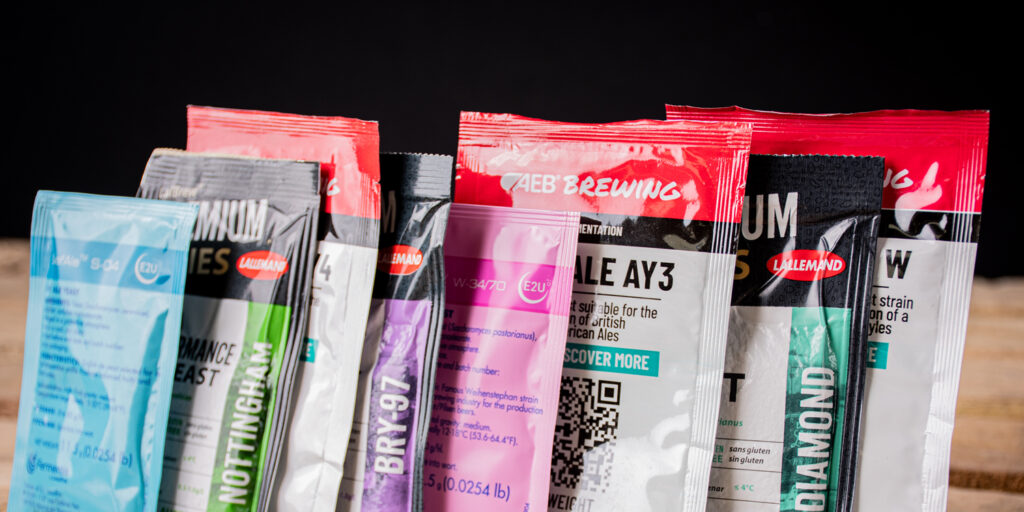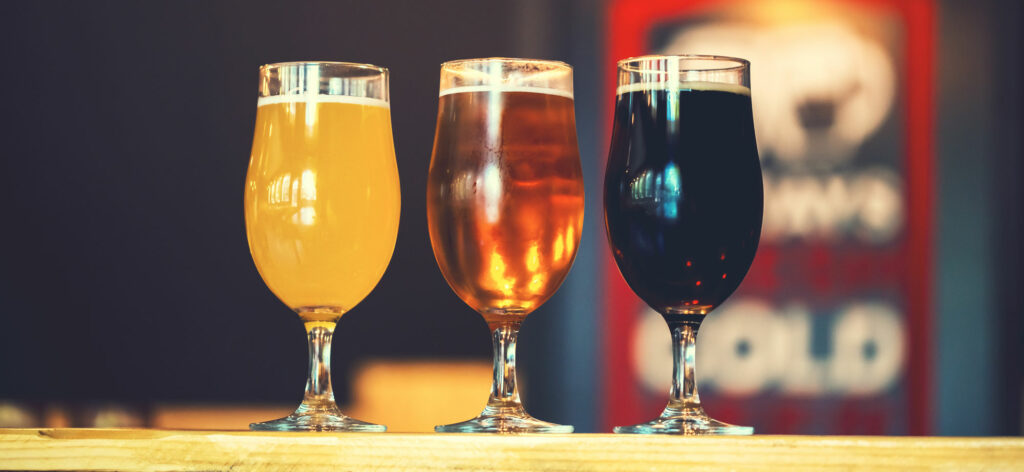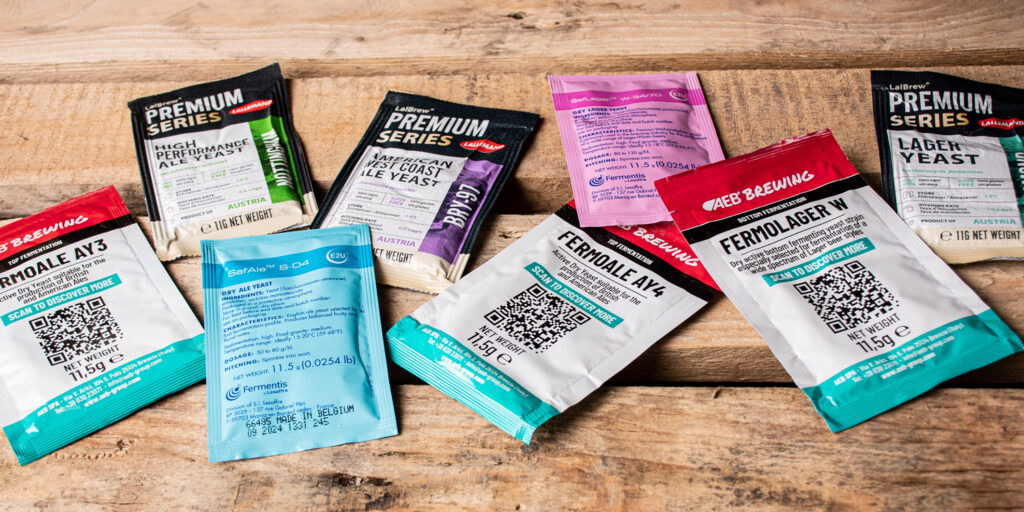When looking at how to choose yeast for beer, understanding the nuances of yeast will help in your decision-making.

This will also help in being a bit experimental. You don’t always have to brew with the same yeast strain. There are a huge number of brewers that use the same strain for all their beers. As a result, beers start tasting the same. Use this opportunity to create something amazing.
Yeast selection can now be as exciting as trying a new experimental hop, so what do you want to consider when selecting a yeast? We’re not going to dive into the Liquid vs Dried Yeast debate in this blog post, but just selecting a new strain for fermentation.
Geterbrewed stocks a wide range of yeasts for brewing, allowing you to create any classic beer, wine or cider. We have a selection of lager and ale yeast in liquid and dried yeast form, various yeasts for cider and mead, professional wine yeasts for home winemaking, and specific yeasts for home distilling.
Where to start…
Look at what you’re trying to achieve when choosing yeast. Dry and Hoppy, Sweet and Malty, Dry and Estery? High ABV or Low ABV? You may want to combine some of these attributes, which is achievable. You may even want to experiment with mixing a few yeast varieties.
If you want to mix yeast, remember that the critical stage in yeast is during the first three days. We recommended adding the different varieties at the start of the fermentation. Not to say that you can’t add yeast at a different stage, but achieving maximum impact earlier is key to increasing attenuation. You could add a second strain after you have achieved your flavour profile from the first yeast. You can blend two yeast strains with complementary flavours and create something unique.
Beer style
The beer style is the easiest place to start when choosing a beer yeast. Some yeasts are style specific. It’s as easy as using Belgium yeast for a Witbeir. Brewing a general style like a lager can get tricky, but deciding on the final beer profile (as mentioned above) will help you choose the best yeast for the job.

What to be considering when choosing yeast?
The brew day…
Yeast can be a bit sensitive. Think about when you will be brewing when ordering. Liquid yeast has many varieties but a short shelf life. So, if you choose a liquid yeast, make sure you can brew with it in time. Dry yeast has a longer shelf life and may need yeast nutrients. Ensure you have everything you need, and deciding when you’re brewing is a good starting point.
Also, look at the time of year. Temperature is a big factor when fermenting. Brewing a lager in the Summer can be tricky as you must ferment at low temperatures. This means you will need the equipment to maintain this.
The equipment…
As mentioned above, look at your brewing equipment. Can you maintain the optimal temperature? Can you pressure ferment? This will determine what yeasts and even what beer styles you can choose.
Cost factors when choosing Brewing Yeast
If you’re concerned about the monetary value, it is insignificant for the amount of yeast per bottle. You can choose premium-quality brewing yeast without breaking the bank. The yeast you choose will depend mainly on the style of beer you are brewing. Luckily there are a lot of resources to guide you in the right direction.
What types of Brewing Yeast are there?
You are spoilt for real choice. We have a massive range of ale yeasts and lager yeasts plus speciality strains that allow you to brew a range of beers, for example, Saison, Belgian Ales, and Wheat Beers. There are options for all beer styles in dry or liquid yeasts.
If you need help selecting the correct yeast strain, don’t hesitate to get in touch.
Lager Yeast (Bottom-Fermenting Yeast)
The obvious choice is lager yeast if you want to brew a lager. Temperature is critical for successfully brewing a lager. Lager yeast usually brews at around 7 to 15°C. This yeast will also take longer to finish fermenting. These are things to consider when using this yeast, as you will need good, consistent temperature control and space to keep your fermenter for a few weeks. If you can’t ferment at the lower lager temperature ranges, you may consider using a lager yeast that ferments at ale temperatures. Try the Californian Lager Yeast from Mangrove Jacks. It ferments at higher temperatures than most lager yeasts. You can also try any Kveik Yeast. Technically an ale yeast; however, we have seen impressive results when used in lagers. It will give a clean finish and can ferment at very high temperatures.
Lager is best broken into two groups
- Dry
- Full (Think malty, Munich Helles style)
Use Lager Yeast for: Lagers, Pilsners, Bocks, Märzen, and Dortmunders, Helles, Rotbier, Bock/Maibock, Oktoberfest, Eisbock, Doppelbock, Leichtbier, Dunkel, Rauchbier, among others
Ale Yeast (Top-Fermenting Yeast)
Ale yeast (Saccharomyces cerevisiae) ferments at temperatures 10 to 25°C. This is reasonably practical for home brewers. The ideal temperature is around 18 to 22°C, which is relatively easy for most to maintain. There are a few ale strains that produce fruity esters while fermenting. At the same time, others have a very clean profile with very few flavours added. Flocculation and alcohol tolerance vary from low to high, so an ale strain will likely work fine, no matter the beer style you’re brewing.
Ale can be broken down further.
- Clean (allows the malt and hops to shine through)
- Fruity (historically popular in the UK and super quick at fermenting)
- Hybrid ( like a California Common yeast that ferments lager at ale temperature, check out the Mangrove Jacks m54)
- Phenolic (Think Belgian and German Weiss, high attenuation and low flocculation)
- Eccentric (Unusual flavour compounds and mainly Belgian styles)
Use Ale Yeast for: Ales, IPA, NEIPA, Stouts, Porters, Wheat beers, Kölsch, Blondes, Altbier, Bitter, Belgian Dubbel, Belgian-Style Tripel, Belgian-Style Quadrupel, Witbier, Saison, Lambic, Koelsch, Weisse, Gose, Hefeweizen, Weizen, Weizenbock, Rauchbier, to name a few.

What’s the best yeast fermentation temperature?
All yeast packets have recommended fermentation temperature ranges. The key to successful fermentation is to ensure the temperature remains constant. Yeast doesn’t respond well to fluctuations in fermentation temperatures. You can create some exciting results by using yeasts in unorthodox ways, but usually, it’s best to keep to the recommended temperature ranges.
Some yeasts respond differently at different temperature ranges. For example, a wheat beer yeast fermented at 17 degrees will produce banana flavours, yet the same yeast fermented at 24 degrees will produce clove flavours. Our recommendation is to aim for the recommended fermentation ranges and keep a focus on maintaining that temperature.
Yeast Characteristics
The yeast’s characteristics can help you decide which one you use in your beer, wine or cider.
Attenuation
Attenuation is the percentage of sugar that the yeast can convert into alcohol. The amount will be shown as a percentage or as high, medium or low.
- High Attenuation: 79% and higher
- Medium Attenuation: 73 to 77%
- Low Attenuation: 72% and lower
If you have 75% Attenuation, 75% of the sugars in your wort will be converted into alcohol. A yeast with low attenuation will leave a brew with more sugar and body than one with high attenuation.
Example: If your brew has an OG of 1.050 and you have 75% attenuation. The yeast will ferment 75% of the gravity sample. 75% of 50 gravity points is about 38 gravity points. So your final gravity should be about 1.012 ( 50 – 38 = 12). This will give you about 4.99% ABV. (OG – FG) x 131.25 = ABV
Flocculation
This refers to the clumping of yeast cells into clusters. These clumps are called flocs. This typically happens at the end of fermentation. The flocculation rate will determine how quickly the beer will clear. High flocculating yeasts sink to the bottom of the fermenter quicker and produce clearer beers.
Alcohol Tolerance
This is the amount of alcohol the yeast can tolerate before becoming inactive. As the alcohol increases, the yeast becomes more dormant and stops fermenting. The more alcohol the yeast can handle, the higher percentage of ABV you’ll get in the final brew.
- Low: 5% and lower
- Medium-Low: 4-8%
- Medium: 5-10%
- Medium-High: 8-12%
- High: 10-15%
- Very High: 15% and higher
Optimal Temperature Ranges
This is a range of temperatures a yeast strain is at its happiest. Keeping your temperature in this range will ensure your yeast ferments optimally. If the temperature is too low, fermentation will be slow or not start. If it is too high, you might get off-flavours and possibly need to dump the whole brew.
Flavour Profile
Defining a yeast flavour profile is difficult, and it takes some guesswork. When yeast is said to impart “fruitiness”, it will add esters that taste like fruit. Usually, the higher temperature you ferment at, the more these flavours will be present. Yeasts can transform the final flavour of your beer. They can emphasise your beer’s malt or hop profiles or add fruity, sweet, or dry finishes.
In conclusion
Choosing yeast for beer can seem a bit daunting. However, knowledge is power. The first step is to know your yeast parameters and what it can do for your beer. After that, it’s down to your skills as a brewer and ensuring your yeast is happy. Successful brewing boils down (pun intended) to SIT – Sanitation, Information and Temperature. And yeast needs all these factors, ensuring you get the best brew possible.